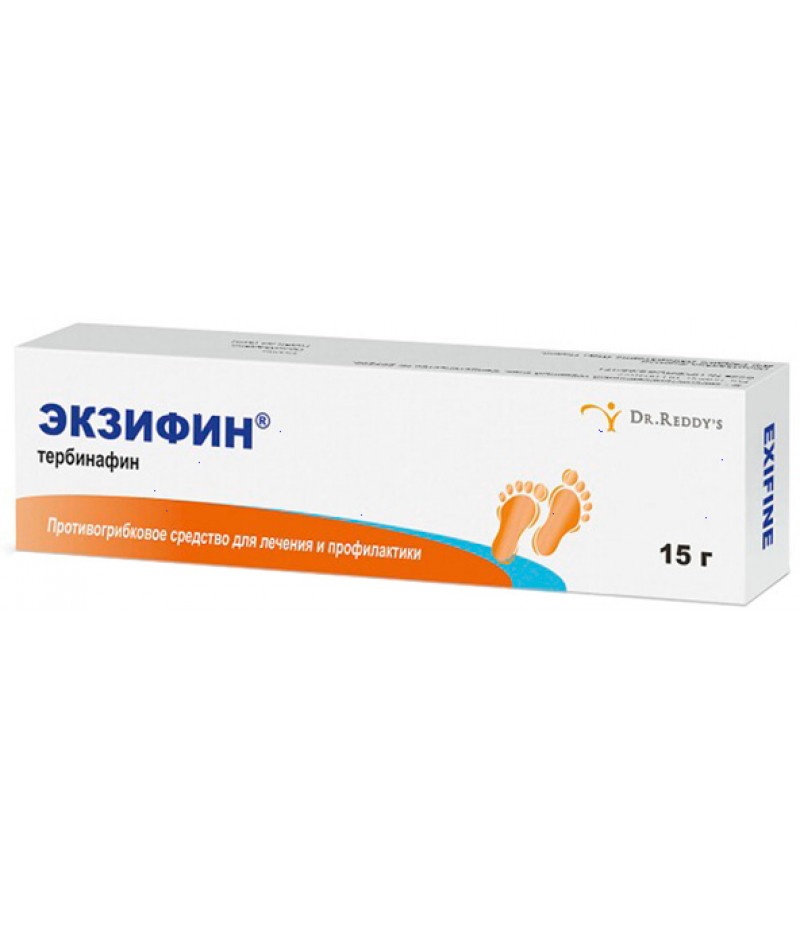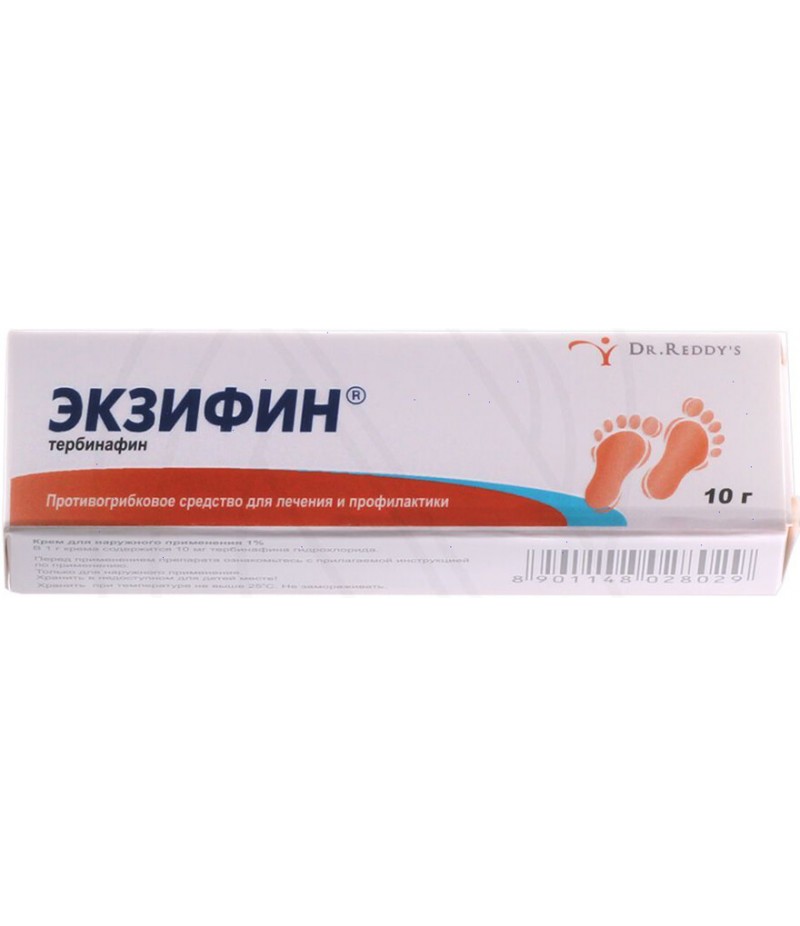Exifine tabs 250mg #16
- $48.47
- 2 or more $47.50
- 3 or more $46.65
- Availability:In Stock
Exifine user manualReed more and buy Exifine on this pageCompositionThe active substance of the drug is terbinafine.Additional components of tablets: MCC, pregelatinized starch, colloidal silicon anhydrous, sodium starch glycolate..
Tags: tabs
Exifine user manual
Reed more and buy Exifine on this page
Composition
The active substance of the drug is terbinafine.
Additional components of tablets: MCC, pregelatinized starch, colloidal silicon anhydrous, sodium starch glycolate, magnesium stearate.
Auxiliary components of the cream: stearyl alcohol, cetyl alcohol, cetyl palmitate, sorbitan stearate, sodium hydroxide, water, benzyl alcohol, isopropyl myristate, polysorbate 60.
Form of issue
Exifine tablets are sold, as well as ointment.
pharmachologic effect
The drug is an antifungal agent.
Pharmacodynamics and pharmacokinetics
The active substance of the drug belongs to allylamines. It acts as an antifungal. At low concentrations, it acts as a fungicidal agent on yeast fungi, Microsporum canis, Trychophyton dermatophytes, Epidermophyton floccosum, mold fungi and some dimorphic fungi. It also has a fungistatic effect on Candida fungi and mycelial forms.
Exifine, getting into the body, disrupts the biosynthesis of ergostrotal membrane of the fungus by blocking the enzyme squalene-epoxidase.
In case of internal application, the preparation accumulates in the skin, hair and nails in an amount sufficient for fungicidal action.
When taken orally, it is absorbed well. Half of the dosage is absorbed after 0.8 hours. It is distributed after 4.6 hours. After 60-120 minutes after application the maximum concentration is reached. Eating does not affect the action of the medicine. Bioavailability - 80%.
The degree of connection with plasma proteins is 99%. The active substance spreads rapidly in the tissues. It enters the secret of the sebaceous glands and accumulates in high concentrations in the subcutaneous tissue, hair follicles, skin integuments and hair. Half-life is approximately 17 hours.
Metabolized with the formation of inactive metabolites in the liver. About 80% of the dose is excreted in the urine in the form of metabolites, the rest - with feces.
Can excrete with breast milk.
Indications for use
The tablets are shown with:
onychomycosis;
mycosis of the scalp;
candidiasis of the skin and mucous membranes;
mycosis of the skin and nails caused by Trychophyton, Epidermophylom floccosum and Microsporum;
severe dermatomycosis of the smooth skin of the extremities and trunk, which require systemic therapy.
Contraindications
The cream should not be applied in case of hypersensitivity to one of the components that are in its composition.
Contraindications when using tablets are as follows:
children under 2 years;
hypersensitivity to the components of the drug;
lactation;
pregnancy.
With care, tablets are used when:
metabolic diseases;
hepatic insufficiency;
renal failure;
tumors;
blood diseases;
psoriasis;
alcoholism;
pathology of the vessels of the extremities.
Side effects
Negative adverse reactions with the use of tablets are usually temporary. Among them note the following:
digestive system: a feeling of a full stomach, nausea, pain, indigestion, loss of appetite, diarrhea, a violation of taste perception (restored after discontinuation);
immune system: urticaria, erythema multiforme;
musculoskeletal system: myalgia, arthralgia;
other: headache, increased fatigue, malaise.
In rare cases, depression, cholestasis, hepatitis, jaundice, increased transaminase levels of the liver, paresthesia, dizziness, hypoesthesia, increased anxiety, neutropenia, thrombocytopenia, agranulocytosis, systemic allergic reactions, psoriasis exacerbation, severe skin reactions, increased hair loss are possible.
The use of tablets should be discontinued with the appearance of hepatobiliary dysfunction and the progression of skin rashes.
Instructions for use Exifine (Method and dosage)
Tablets are administered orally. The course and scheme of admission are set individually and depend on the disease.
Instruction for Exifine reports that adults are usually prescribed 250 mg of the drug per day. The duration of treatment, depending on the indications, can be as follows:
onychomycosis - approximately 6-12 weeks. In case of nail lesions (except the big toe), young patients can take medicine less than 12 weeks. When the big toe is injured, a three-month course is usually prescribed. If the nails grow too slowly, therapy can be extended to six months or more;
fungal infections of the skin - with the localization of lesions between the fingers, on the soles or the type of "socks" treatment lasts from 2 to 6 weeks; in the case of infections on other parts of the body, as well as mycoses associated with Candida, 2 to 4 weeks; with mycosis head, provoked by Microsporum canis, - more than a month.
For children, the administration of 125 mg of the drug is usually given daily (weight 20-40 kg). If the weight of the child is up to 20 kg, the daily dosage is 62.5 mg (the fourth part of the pill), and with a weight of 40 kg you can take 250 mg per day. The course of mycosis therapy of the scalp is about a month. In the case of Microsporum canis, the reception may be longer.
The cream is applied externally. The skin in the place of application must first be cleaned and dried. For those who use Exyfin Ointment, the instructions for use recommend applying it in a thin layer on the affected and adjacent skin areas, lightly rubbing. If the infection is accompanied by diaper rash, the affected areas can be covered with gauze (including at night). Treatment scheme depends on the disease:
dermatomycosis of the trunk, feet and shins - the cream is applied once a day for 7 days;
multicolored lichen - the cream is applied 1-2 times / day for 14 days;
inguinal epidermophytia - the cream is applied once a week for 7-14 days;
Candidiasis of the skin - the cream is applied 1-2 times / day for 7-14 days.
The duration of therapy depends, first of all, on the indications and severity of the disease. Reduction in the severity of its manifestations should be observed in the first days of application.
In order to prevent relapse of mycosis, stop cream can use 2-3 courses (each for 2 weeks). Break between them - a week.
Overdose
When taking tablets at elevated dosages, nausea, headache, dizziness, pain in the lower abdomen, in the epigastric region, vomiting are possible. As a treatment, the patient is prescribed gastric lavage and the subsequent reception of activated carbon. Therapy is symptomatic.
About Exifine cream with no cream. If the drug accidentally got inside, the same negative reactions can develop as in the case of overdose of tablets.
Interaction
The drug blocks CYP206 and biotransfication in the body of tricyclic antidepressants, as well as beta adrenoblockers, selective blockers of serotonin uptake, MAO inhibitors of type B, antiarrhythmic and antinsychotic drugs.
Inducers of CYP450 enzymes can lead to faster release of the active substance Exifine. Inhibitors of these enzymes, on the contrary, can slow the biotransformation and excretion of terbinafine. This combination may require correction of dosages.
Terbinafine with oral contraceptives can cause a disorder of the menstrual cycle.
When combined with ethanol and hepatotoxic drugs, the likelihood of a hepatotoxic effect increases. Exifine also reduces the clearance of caffeine and increases its half-life.
Storage conditions
Tablets should be kept in a dark place inaccessible to small children. Temperature up to 25 ° С.
Shelf life - 3 years from the date of manufacture.
Reviews about Exifine
Reviews about Exifine are usually positive. Those who have used this drug characterize ointment and pills as an effective quick-acting drug.
On side effects reported rarely. Only some reviews on Exifine in the form of ointments tell about the burning sensation at the beginning of the application, which itself passes and does not require the withdrawal of the drug. Among the positive moments, patients also note that the cream does not leave stains on clothes and has quite a pleasant smell.
Reviews of Exifine tablets report that they are often used as a cheaper analogue of expensive Lamisil.




